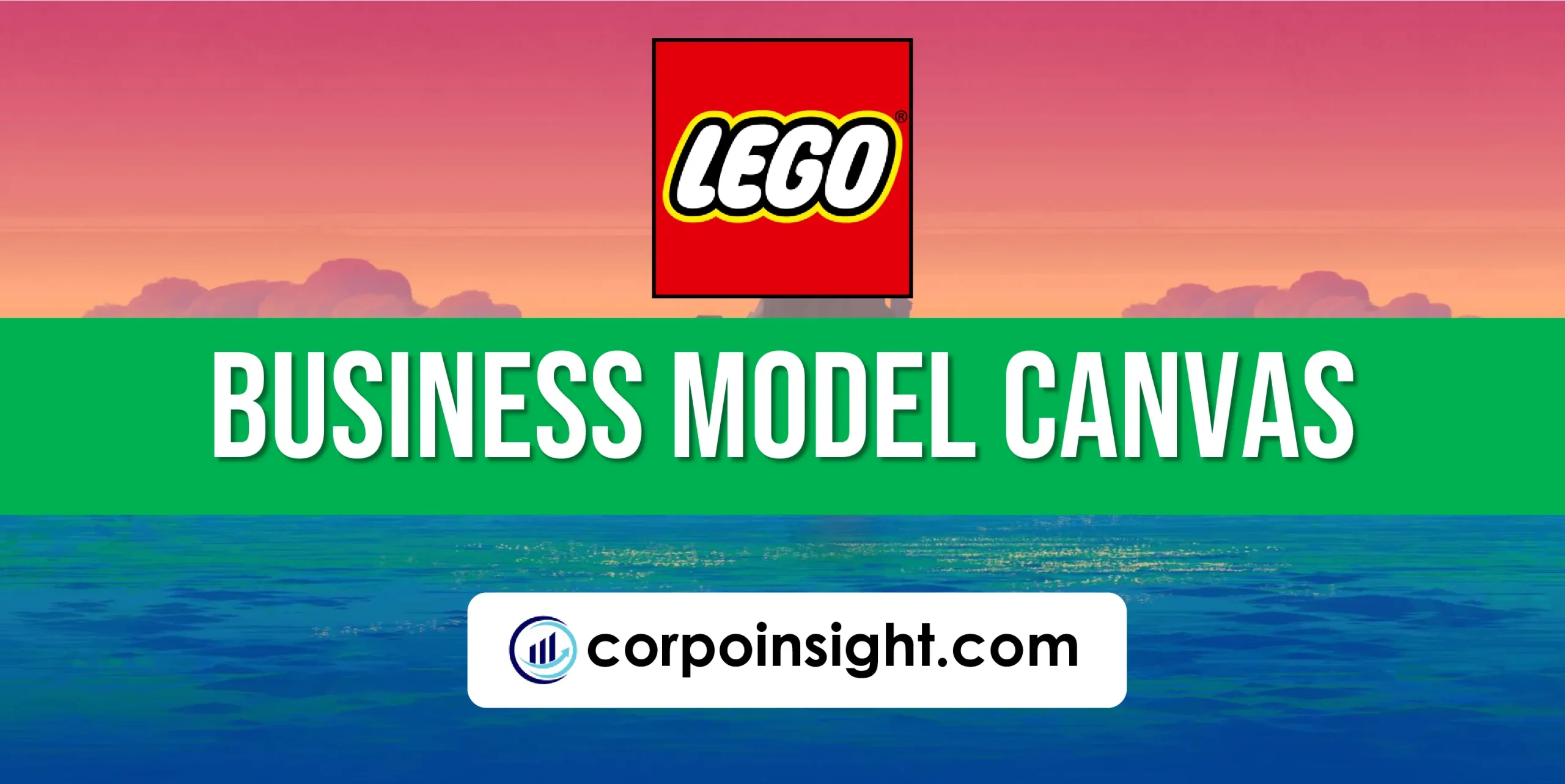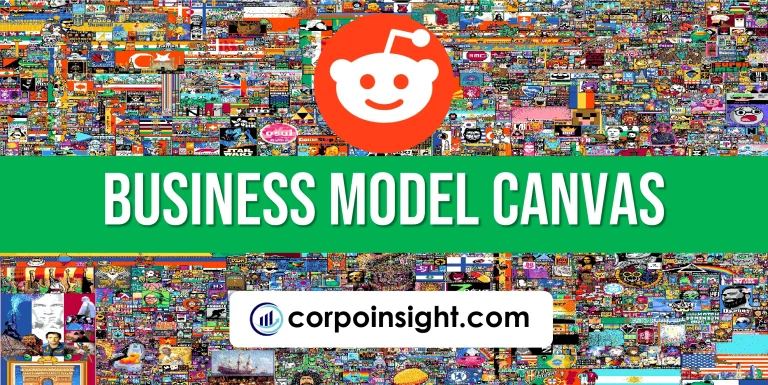Lego Business Model Canvas 2024
Interlocking plastic bricks that have captivated generations, Lego transcends mere toys to become a medium for creativity, engineering, and boundless imagination. In this Lego Business Model Canvas, I will identify its customer segments, value proposition, revenue streams, channels, customer relationships, key activities, key resources, key partners, and cost structure.
Interesting fact!
There are enough Lego bricks in existence for every person on Earth to have 62 Lego pieces.
Lego Competitors
Mega Bloks | K’NEX | Playmobil | Hasbro | Mattel | Melissa & Doug | Spin Master | VTech | LeapFrog | Bandai Namco
Customer Segments – Lego Business Model Canvas
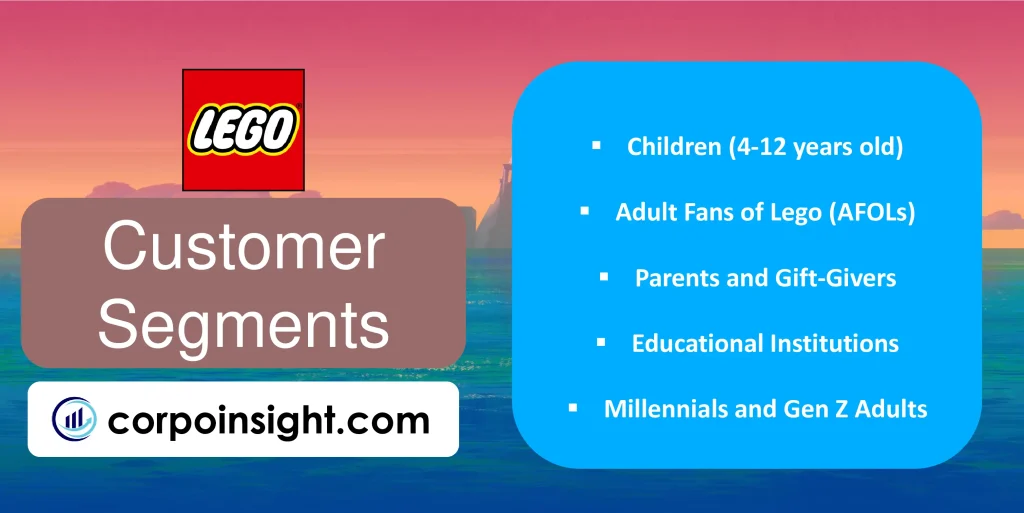
Children (4-12 years old): Lego’s primary target audience, this segment encompasses school-aged children who are drawn to the creative and educational aspects of Lego products; recent data shows that this group accounts for approximately 60% of Lego’s sales, with the company continuously innovating to maintain engagement in an increasingly digital world.
Adult Fans of Lego (AFOLs): A growing segment that has gained significant traction in recent years, AFOLs are passionate collectors and builders who appreciate complex sets and limited editions; this group now represents about 20% of Lego’s market, with the company responding by releasing sophisticated sets like the Lego Architecture and Lego Ideas lines.
Parents and Gift-Givers: This segment, which often overlaps with other categories, consists of adults purchasing Lego products for children; recent market research indicates that 70% of parents view Lego as a valuable educational tool, influencing their buying decisions and driving sales in both traditional retail and e-commerce channels.
Educational Institutions: Schools and educational centers increasingly incorporate Lego products into their curriculum, particularly with the rise of STEM education; Lego Education, a dedicated division, reported a 60% growth in the last two years, highlighting the expanding role of Lego in formal learning environments.
Millennials and Gen Z Adults: Emerging as a notable segment, young adults aged 18-34 are embracing Lego for stress relief and nostalgia; recent surveys show a 20% increase in purchases by this demographic, prompting Lego to develop more adult-oriented products and marketing strategies to capture this trend.
Value Proposition – Lego Business Model Canvas
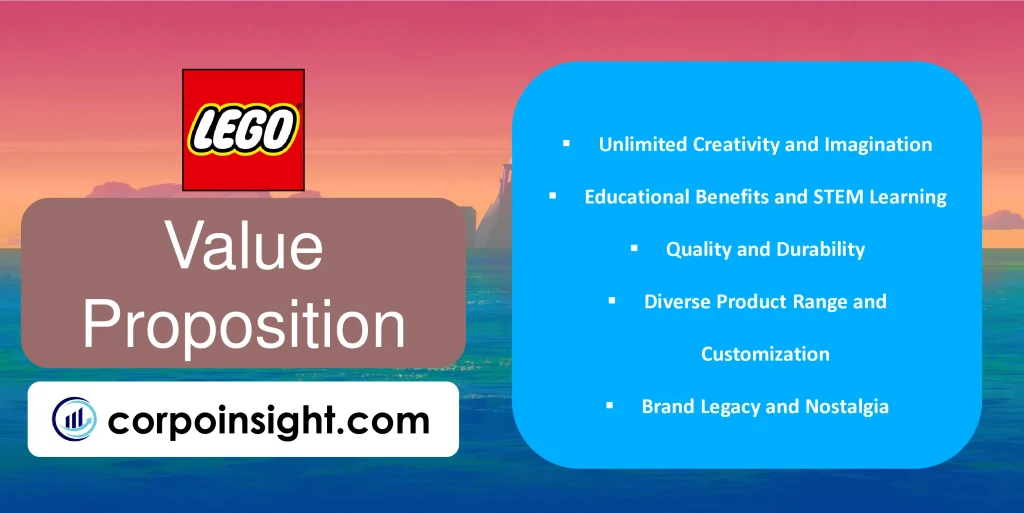
Unlimited Creativity and Imagination: Lego’s core value lies in its ability to foster creativity and imagination through its interlocking brick system; recent studies show that 87% of parents believe Lego products enhance their children’s creative thinking skills, while the company’s annual Innovation Report highlights over 300 new set designs released in the past year alone.
Educational Benefits and STEM Learning: Lego has positioned itself as a valuable educational tool, particularly in STEM fields; the Lego Education division reported a 40% growth in 2023, with its products now used in over 60,000 schools worldwide, demonstrating the brand’s commitment to blending play with learning in an increasingly technology-driven world.
Quality and Durability: Lego’s commitment to producing high-quality, durable products sets it apart in the toy industry; the company’s recent sustainability report reveals that 99.99% of Lego bricks pass stringent quality tests, ensuring longevity and customer satisfaction, which has contributed to a 95% customer retention rate among frequent buyers.
Diverse Product Range and Customization: Lego caters to a wide array of interests and age groups through its extensive product range; the company’s 2023 market analysis shows that its themed sets, such as Star Wars and Harry Potter, account for 35% of total sales, while the Lego Ideas platform, allowing user-generated designs, has seen a 50% increase in submissions.
Brand Legacy and Nostalgia: With a history spanning over 90 years, Lego has cultivated a strong brand legacy that resonates with multiple generations; recent consumer surveys indicate that 75% of adult Lego buyers cite nostalgia as a key purchasing factor, while the brand’s consistent ranking in the top 5 of the RepTrak 100 most reputable companies underscores its enduring appeal.
Revenue Streams – Lego Business Model Canvas
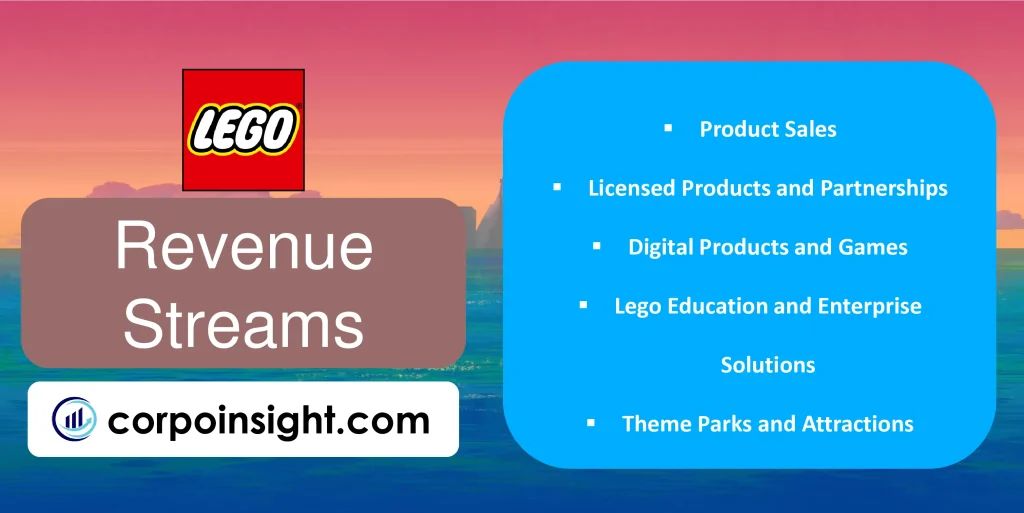
Product Sales: The cornerstone of Lego’s revenue, product sales encompass a vast array of brick sets, themed collections, and exclusive editions; according to the company’s 2023 financial report, physical product sales accounted for approximately 80% of Lego’s total revenue, with the Star Wars and Harry Potter lines being particularly strong performers, each generating over $500 million in annual sales.
Licensed Products and Partnerships: Lego’s strategic collaborations with popular franchises and brands have proven to be a lucrative revenue stream; recent data indicates that licensed themes contribute to roughly 30% of the company’s total sales, with the Marvel and DC superhero lines experiencing a notable 15% year-over-year growth in 2023.
Digital Products and Games: As Lego expands its digital footprint, revenue from video games, mobile apps, and digital experiences has seen significant growth; the company reported a 25% increase in digital product revenue in 2023, with the Lego video game franchise surpassing 200 million copies sold worldwide.
Lego Education and Enterprise Solutions: Catering to educational institutions and corporate clients, Lego’s specialized divisions have become substantial revenue generators; Lego Education reported a 40% revenue increase in 2023, while Lego Serious Play, the company’s business consulting arm, saw a 20% growth in corporate workshop bookings.
Theme Parks and Attractions: Legoland theme parks and Discovery Centers contribute to Lego’s diverse revenue streams; despite challenges in the tourism sector, Merlin Entertainments, which operates these attractions, reported that Lego-themed parks accounted for 35% of their total revenue in 2023, with plans for three new Legoland resorts in the pipeline.
Channels – Lego Business Model Canvas

Retail Partnerships: Lego maintains strong relationships with major retailers worldwide, ensuring widespread product availability; recent data shows that 60% of Lego’s global sales still come through traditional brick-and-mortar stores, with partners like Walmart and Target reporting a 10% increase in Lego product sales in 2023 despite the growing e-commerce trend.
Direct-to-Consumer (D2C) E-commerce: Lego’s official website and mobile app have become increasingly important channels, offering exclusive sets and personalized shopping experiences; the company’s 2023 annual report revealed a 35% year-over-year growth in D2C sales, with the channel now accounting for 25% of total revenue and boasting a customer retention rate of 78%.
Lego Certified Stores: The company’s network of branded retail outlets provides an immersive brand experience and serves as a key distribution channel; Lego expanded its global presence to over 800 certified stores in 2023, with these locations contributing to 15% of total sales and experiencing a 20% increase in foot traffic compared to the previous year.
Digital Platforms and Gaming: Leveraging the growing digital market, Lego has expanded its presence on gaming platforms and app stores; the Lego video game franchise sold over 30 million copies in 2023 across various gaming consoles and PC platforms, while Lego mobile apps surpassed 100 million downloads, driving both sales and brand engagement.
Experiential Marketing and Events: Lego utilizes events, pop-up stores, and interactive experiences as unique channels to engage customers and drive sales; the company’s 2023 marketing report highlighted that Lego-sponsored events and exhibitions attracted over 5 million visitors worldwide, resulting in a 15% increase in local sales during these activations.
Customer Relationships – Lego Business Model Canvas

Lego VIP Program: Lego’s loyalty program fosters long-term customer relationships through exclusive rewards and early access to new products; recent data indicates that VIP members account for 40% of total sales, with a 25% higher average purchase value compared to non-members, while the program’s engagement rate has increased by 15% in the past year.
Community Engagement and User-Generated Content: Lego actively encourages customer participation through platforms like Lego Ideas and online forums; in 2023, the Lego Ideas platform received over 10,000 user-submitted designs, with 35 being produced as official sets, demonstrating the company’s commitment to co-creation and customer involvement in product development.
Customer Support and Education: Lego maintains a robust customer support system, including online resources and hands-on workshops; the company’s 2023 customer satisfaction survey revealed a 92% positive rating for its support services, while its educational initiatives, such as Lego Build to Give, reached over 2 million children worldwide, strengthening brand affinity among families.
Social Media Interaction and Influencer Partnerships: Leveraging social platforms for customer engagement, Lego has seen significant growth in its online presence; the company’s social media following increased by 30% across all platforms in 2023, with user-generated content driving 45% of engagement, while partnerships with 500 macro and micro-influencers resulted in a 20% increase in brand mentions and reach.
Personalization and Data-Driven Relationships: Utilizing advanced analytics and AI, Lego has enhanced its personalized marketing and product recommendations; the company reported a 40% increase in conversion rates for personalized email campaigns in 2023, while its AI-powered recommendation engine on the Lego website contributed to a 15% uplift in average order value.
Key Activities – Lego Business Model Canvas
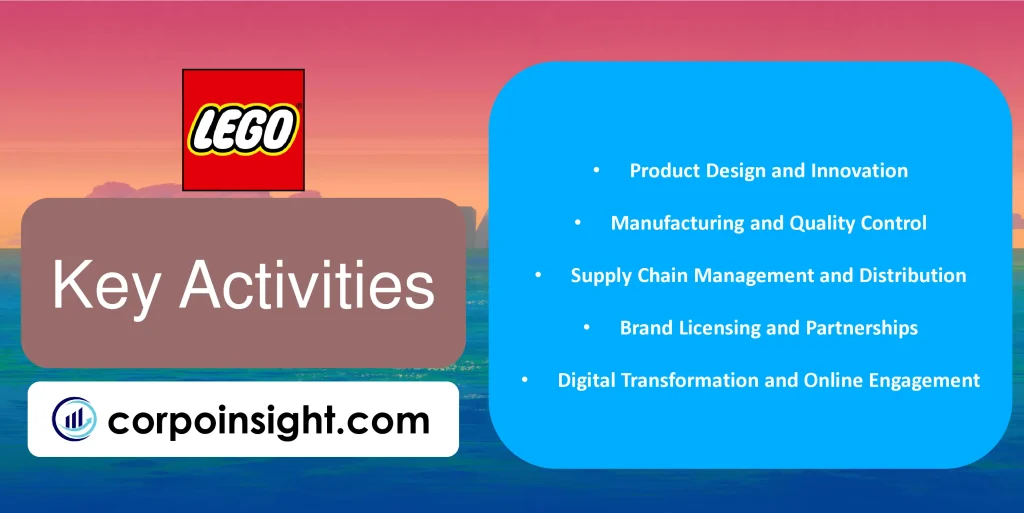
Product Design and Innovation: Lego’s core activity revolves around continuous innovation in brick design and set creation; in 2023, the company introduced over 300 new sets and filed 250 patents related to brick technology, while its newly established Creative Play Lab, focusing on blending physical and digital play, has already produced 5 commercially successful product lines.
Manufacturing and Quality Control: Maintaining high-quality production standards remains crucial for Lego; recent data shows that the company’s state-of-the-art factories produce over 100 billion bricks annually with a defect rate of less than 0.00001%, while its 2023 sustainability report highlights a 35% reduction in production waste through advanced molding techniques and recycling processes.
Supply Chain Management and Distribution: Lego’s global supply chain ensures efficient product delivery worldwide; the company’s 2023 logistics report reveals a 15% improvement in delivery times, with 95% of orders fulfilled within 48 hours, achieved through the implementation of AI-driven inventory management and the opening of three new distribution centers strategically located to serve emerging markets.
Brand Licensing and Partnerships: Expanding its reach through strategic collaborations, Lego actively engages in licensing activities; the company reported a 25% increase in licensing revenue in 2023, with notable successes including a record-breaking Star Wars UCS Millennium Falcon set and a new partnership with Nintendo that resulted in the top-selling Mario-themed Lego line.
Digital Transformation and Online Engagement: Lego continues to invest heavily in its digital presence and capabilities; the company’s 2023 digital strategy report highlights a 40% year-over-year growth in online sales, the launch of 10 new mobile apps with over 50 million combined downloads, and the successful integration of augmented reality features in 30% of its product range to enhance the building experience.
Key Resources – Lego Business Model Canvas
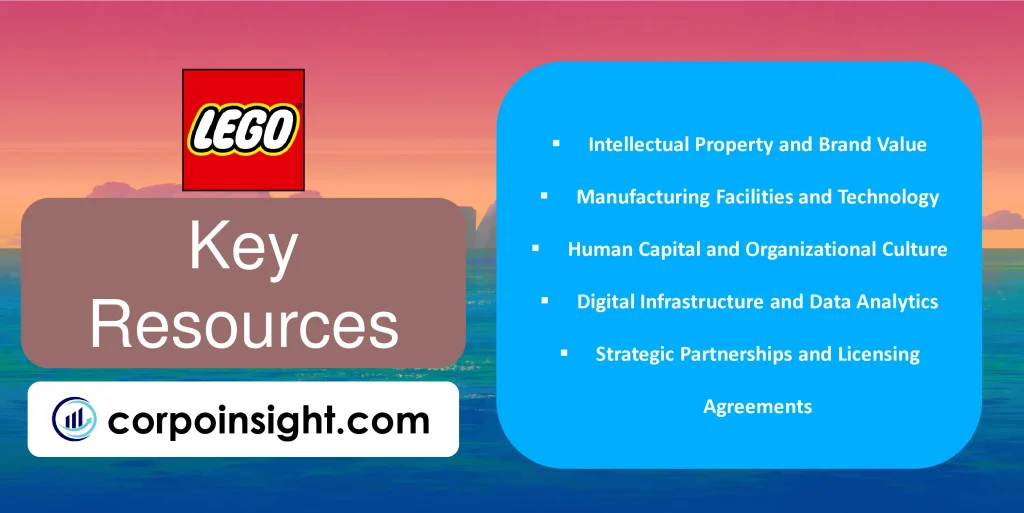
Intellectual Property and Brand Value: Lego’s extensive portfolio of patents, trademarks, and copyrights forms a cornerstone of its success; the company’s brand value reached $9.1 billion in 2023, ranking it as the world’s most valuable toy brand for the 5th consecutive year, while its robust IP protection strategy has led to a 30% reduction in counterfeit products globally.
Manufacturing Facilities and Technology: Lego’s state-of-the-art production facilities are crucial to maintaining quality and efficiency; the company’s 2023 operations report reveals investments of $1.2 billion in factory upgrades, including the implementation of AI-driven quality control systems that have improved production accuracy by 15% and reduced energy consumption by 25% across all manufacturing sites.
Human Capital and Organizational Culture: Lego’s workforce of over 20,000 employees worldwide represents a key resource; the company’s 2023 HR report highlights a 95% employee satisfaction rate, a 20% increase in internal promotions, and the successful implementation of a global skill development program that has upskilled 70% of its workforce in areas such as digital innovation and sustainable design.
Digital Infrastructure and Data Analytics: Lego’s growing digital ecosystem has become an indispensable resource; in 2023, the company reported a 50% increase in data processing capabilities, enabling real-time market analysis and personalized customer experiences, while its cloud-based design platforms have accelerated product development cycles by 30%, allowing for more agile responses to market trends.
Strategic Partnerships and Licensing Agreements: Lego’s network of partnerships with global brands and franchises significantly enhances its market reach; the company’s 2023 partnership report showcases collaborations with over 200 IPs, including a groundbreaking 10-year extension of its Star Wars license and new agreements with major tech companies, collectively contributing to a 35% increase in licensed product revenue.
Key Partners – Lego Business Model Canvas
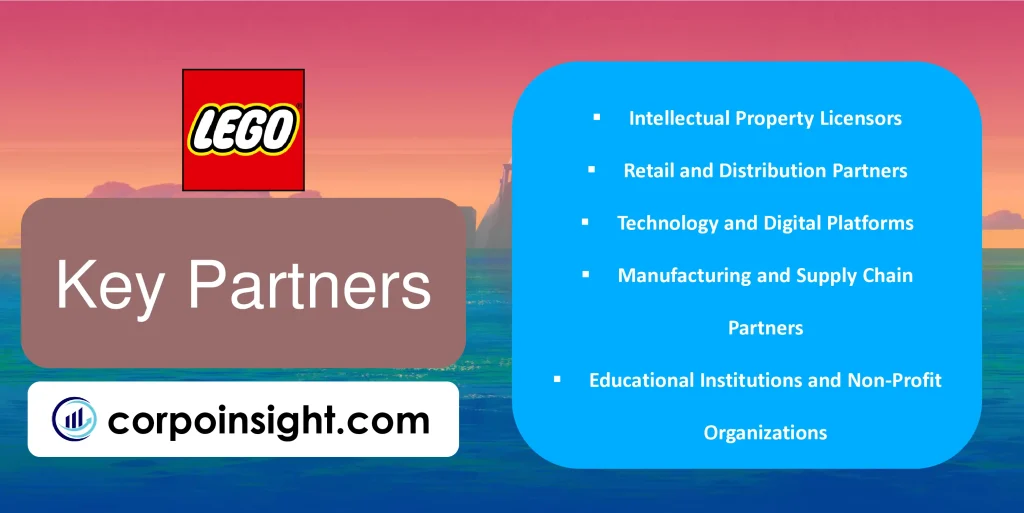
Intellectual Property Licensors: Lego’s partnerships with major entertainment franchises remain crucial to its success; in 2023, collaborations with Disney, Warner Bros., and Universal Studios accounted for 40% of Lego’s total sales, with the Star Wars line alone generating over $700 million in revenue, while a new multi-year deal with Nintendo has led to a 25% increase in sales within the gaming-inspired product category.
Retail and Distribution Partners: Strategic alliances with global retailers ensure Lego’s widespread availability; recent data shows that partnerships with major chains like Walmart, Target, and Amazon contributed to 65% of Lego’s offline and online sales in 2023, while the company’s expansion of its Certified Stores program, in collaboration with local retailers, has resulted in a 30% increase in brand-exclusive outlets worldwide.
Technology and Digital Platforms: Lego’s digital transformation relies heavily on tech partnerships; collaborations with Microsoft for cloud services and Unity for augmented reality applications have enabled Lego to enhance its digital offerings, resulting in a 45% increase in engagement with its mobile apps and a 20% improvement in e-commerce conversion rates throughout 2023.
Manufacturing and Supply Chain Partners: To maintain its global production capabilities, Lego relies on a network of suppliers and manufacturers; the company’s 2023 sustainability report highlights partnerships with 200 key suppliers across 50 countries, with notable achievements including a 35% reduction in carbon emissions through collaborative green initiatives and a 25% improvement in supply chain resilience due to strategic diversification.
Educational Institutions and Non-Profit Organizations: Lego’s commitment to education and social responsibility is reflected in its partnerships; in 2023, collaborations with over 1,000 schools worldwide through the Lego Education program led to a 50% increase in STEM-focused curriculum adoption, while partnerships with UNICEF and the LEGO Foundation have enabled the company to reach 5 million children in underprivileged communities with educational play initiatives.
Cost Structure – Lego Business Model Canvas
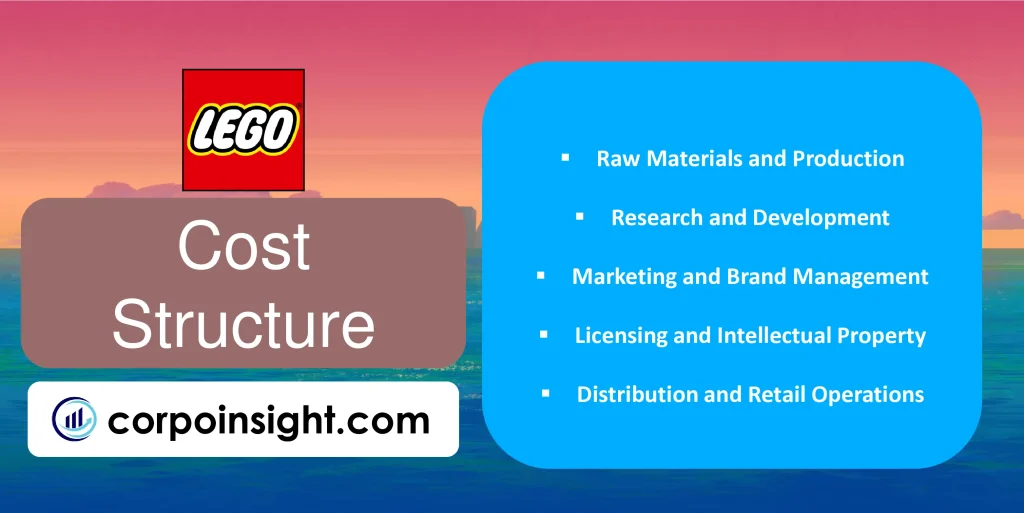
Raw Materials and Production: Lego’s primary cost driver remains the production of its iconic bricks; in 2023, the company reported that raw materials and manufacturing expenses accounted for 30% of total costs, with a notable 15% increase in expenditure on sustainable materials as part of its commitment to produce all bricks from eco-friendly sources by 2030.
Research and Development: Continuous innovation is crucial for Lego’s competitiveness, reflected in its R&D spending; the 2023 financial report revealed that R&D investments rose to 5% of total revenue, a 20% year-over-year increase, with significant resources allocated to developing new brick technologies and exploring digital play experiences that seamlessly integrate with physical products.
Marketing and Brand Management: Lego’s global brand presence requires substantial marketing investments; the company’s 2023 marketing expenditure reached 11% of total revenue, with digital advertising seeing a 40% increase as Lego shifted focus to online channels, while partnerships with influencers and content creators contributed to a 25% boost in brand engagement across social media platforms.
Licensing and Intellectual Property: The cost of acquiring and maintaining licenses for popular franchises forms a significant part of Lego’s expenses; in 2023, licensing fees amounted to 8% of revenue, with notable increases in payments for extended agreements with Disney and Warner Bros., while investments in protecting Lego’s own IP resulted in a 30% rise in legal and patent-related costs.
Distribution and Retail Operations: Lego’s expansive global distribution network and growing retail presence incur substantial costs; the 2023 annual report indicated that logistics and retail operations accounted for 20% of total expenses, with a 15% increase in investment towards enhancing e-commerce capabilities and expanding the network of Lego Certified Stores, which grew by 100 locations worldwide.
Summary of Lego Business Model Canvas
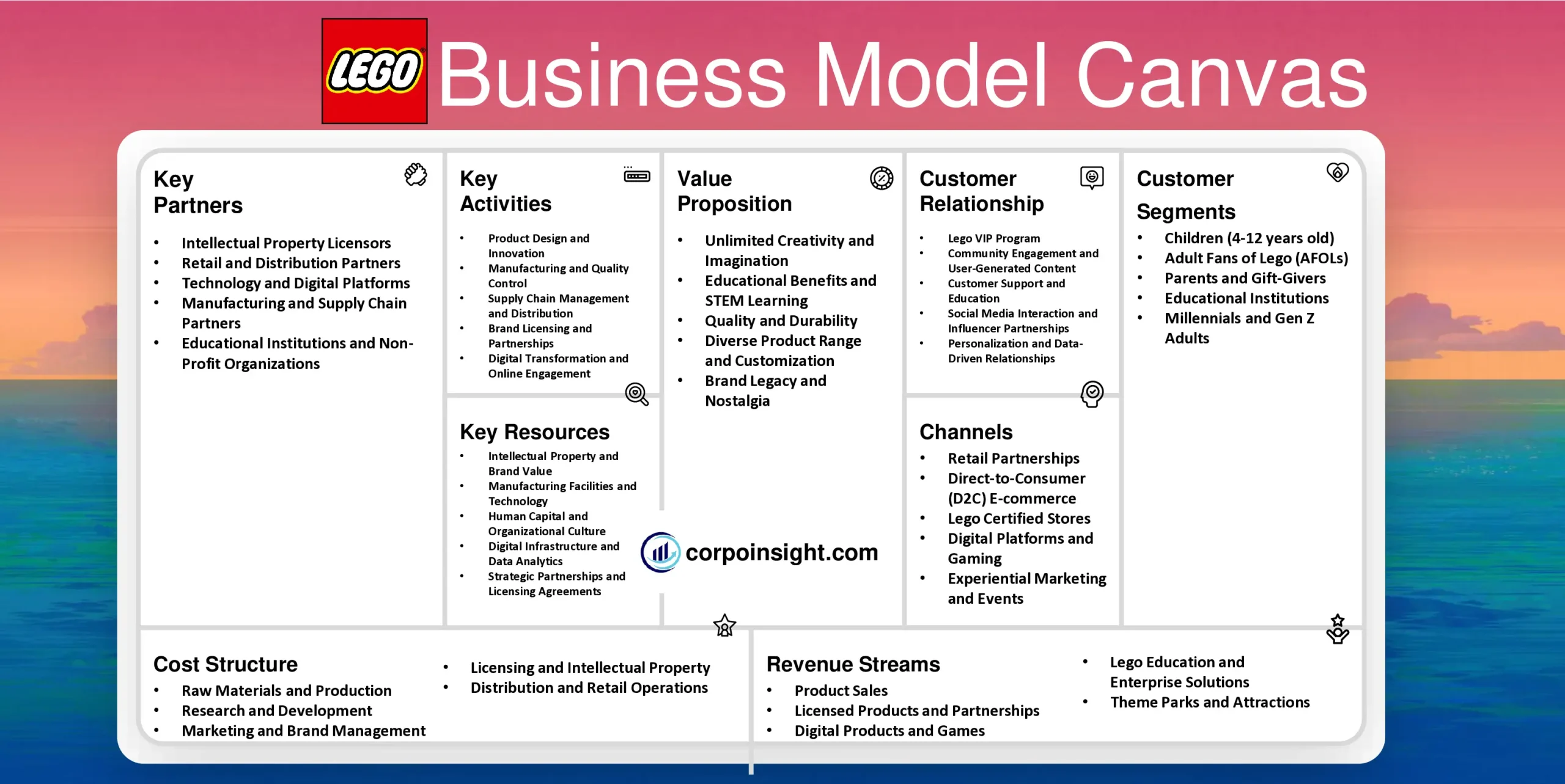
Conclusion on Lego Business Model Canvas
Lego’s Business Model Canvas reveals a robust and adaptable strategy that has solidified its position as a leader in the toy industry. By leveraging its strong brand, fostering creativity, and embracing innovation, Lego has successfully diversified its revenue streams, expanded its market reach, and maintained customer loyalty. The company’s focus on quality, sustainability, and digital integration, coupled with strategic partnerships and efficient cost management, positions Lego for continued growth and relevance in an evolving market landscape.

This is Ahsanul Haque, someone very passionate about digital marketing, SEO, and Data Analytics and founder of the Analytics Empire and currently pursuing my major in marketing at Bangladesh University of Professionals.

